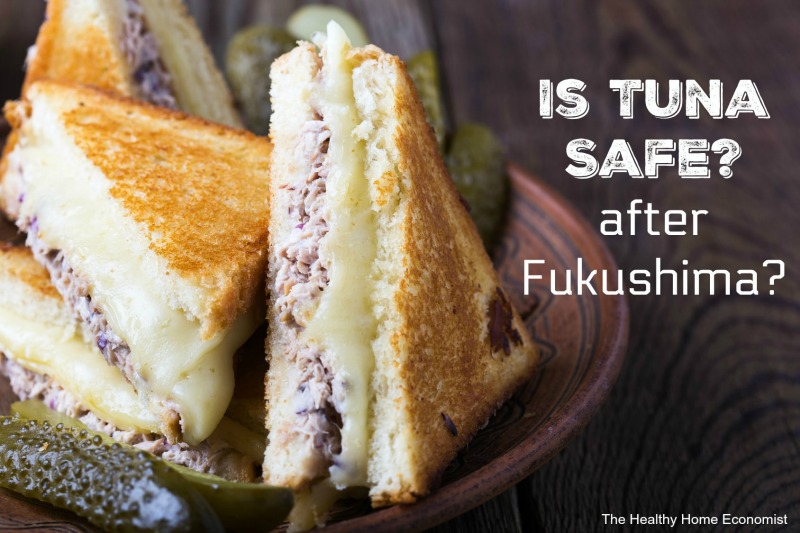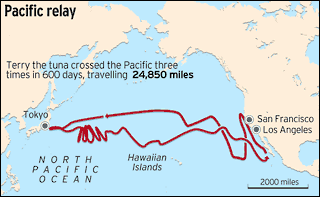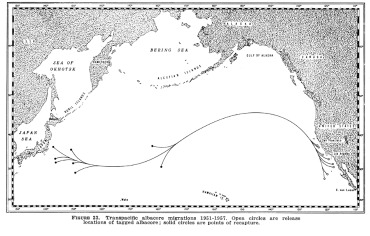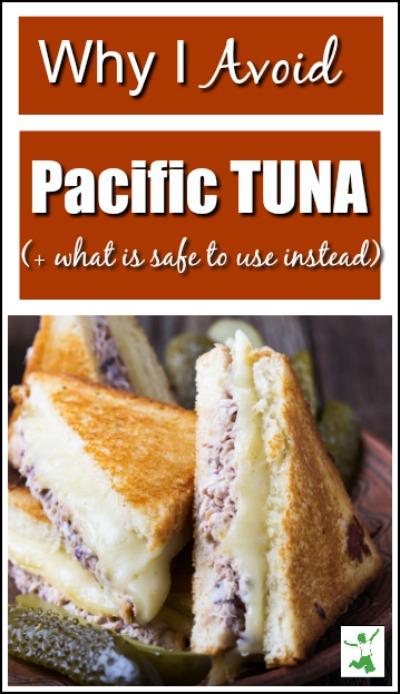
Tuna has always been a staple Real Food in our home. I’ve always taken care to source low mercury, sustainably caught tuna in order to prepare quality tuna steaks for dinner, tuna melts for lunch, or that old standby tuna salad for lunch boxes, quick snacks or just a dollop on a bed of greens. Spicy bluefin tuna rolls are a favorite of my husband when dining at Japanese restaurants.
About a year ago, however, I started to question my choice of tuna for regular consumption. I began reading the reports about the spreading radiation plume in the Pacific from the continuing Fukushima nuclear disaster. I delved into the migratory patterns of various species of tuna. The more I read, the more concerned, and quite frankly, confused I became.
Realizing that my family’s health can’t be wagered on guesses or half-truths, I gathered as much information as I could to arrive at an informed decision. Here’s what I found.
All species of tuna are highly migratory. This means that they swim long distances pretty much throughout their entire lives. These migration patterns are still ill-understood although it is generally agreed upon that they are large.

Pacific bluefin tuna are born near Japan spending their early months swimming in the radiation plume there. They then swim back and forth across the Pacific their entire lives. One tuna nicknamed Terry crossed the Pacific no less than 3 times in the span of only 20 months coming very close to Japan each time. To the right is a chart showing his epic swim.
The information gleaned from Terry the tuna is not new. As early as the 1950’s, tagged albacore tuna were known to swim thousands of miles as shown in this second chart to the right. The open circles off the California coast indicate where they were released and the solid circles closer to Japan indicates where they were recaptured.
 Highly migratory indeed!
Highly migratory indeed!
Atlantic based tuna exhibit the same nomadic patterns. According to National Geographic, high tech tags of Atlantic bluefin tuna revealed the following:
A team of international scientists documented two giant bluefins tagged within minutes of each other off the coast of Ireland. The two fish swam to opposite sides of the Atlantic Ocean–ending up more than 3,000 miles (5,000 kilometers) apart. One of the fish traveled 3,730 miles (6,000 kilometers) southwest to waters about 186 miles (300 kilometers) northeast of Cuba. The other remained in the eastern Atlantic and moved off the coasts of Portugal.
According to the Food and Agriculture Organization of the United Nation (FAO)s, all species of tuna, not just bluefin and albacore, are considered highly migratory, again with the reasons for these patterns not well understood. Here is a breakdown of the tuna species and where they are located according to a report by the FAO:
- Albacore tuna (Thunnus alalunga), which occurs in tropical and temperate waters worldwide.
- Bluefin tuna (Thunnus thynnus), mostly found in temperate waters of the Atlantic, including the Mediterranean, and Pacific Oceans. It is noted that since the adoption of UNCLOS, bluefin tuna in the northern Pacific has been identified as a different species, Pacific bluefin tuna (Thunnus orientalis) while bluefin in the Atlantic has been re-named Atlantic bluefin tuna.
- Bigeye tuna (Thunnus obesus), found in the Atlantic (but absent from the Mediterranean), Indian and Pacific Oceans.
- Skipjack tuna (Katsuwonus pelamis) with a worldwide distribution in tropical and temperate waters.
- Yellowfin tuna (Thunnus albacares), also with a worldwide distribution in tropical and sub-tropical more temperate seas, but absent from the Mediterranean.
- Blackfin tuna (Thunnus atlanticus) found in the western Atlantic in tropical and warm seas.
- Little tuna (Euthynnus alleteratus and E. affinis), with E. alleteratus found in tropical and subtropical waters of the Atlantic, including the Mediterranean, the Black Sea, the Caribbean Sea and the Gulf of Mexico, and E. affinis in the Indian and Pacific Oceans. It is noted that presently, E. alleteratus is called little tunny and E. affinis is called kawakawa.
- Southern bluefin tuna (Thunnus maccoyii), in temperate waters of the southern hemisphere in the Atlantic, Indian and Pacific Oceans.
- Frigate and bullet tuna (Auxis thazard and A. rochei) found in the Atlantic (including the Mediterranean Sea where only A. rochei is found), Indian and Pacific Oceans.
So Tuna Swim. A Lot. So What?
The fact that tuna swim great distances, constantly moving and migrating means that tuna in the Pacific more than likely will have passed through the growing Fukushima radiation plume at some point in their lives, probably numerous times.
With long-lived varieties like albacore (11-12 years) and bluefin (up to 20 years), this is especially true. With much smaller, shorter-lived tuna like the skipjack (about 8 years), less so.
Is the Fukushima Radiation Even Really a Problem?
The answer to this question depends on who you ask. Some reports say yes, the Pacific-based radiation plume from Fukushima is a serious problem and growing worse as 300 tons of radioactive water pours into the Pacific every single day with no end in sight for years. Unbelievably, Japan’s government only acknowledged the urgency of the situation in September 2013.
On the other hand, a comprehensive assessment by the World Health Organization (WHO) concluded that radioactive particles that are making their way to North American waters will have a limited effect on human health, with concentrations below WHO safety levels.
The most unsettling data to date is that the continued outflow of radioactive water from Fukushima now no longer just contains cesium isotopes. It now also contains the more worrisome strontium-90 which is a bone-seeking isotope.
Who is right? Who is wrong?
One thing is true, Fukushima is a nuclear disaster never before experienced in human history so all theories and probabilities are on the table.
Dr. Ken Buessler, a world expert in marine radioactivity with the Woods Hole Oceanographic Institution in Massachusetts who is leading an international research team tracking Fukushima’s trails in the Pacific has this to say:
We still don’t know the answers to many important questions concerning the impacts of Fukushima radionuclides on the oceans. For example, we still don’t have a good handle on how much radioactivity was released, and we don’t fully understand where it has ended up, and that holds for the ocean waters, seafloor sediments, and for marine biota, such as tuna.
Caution Seems to Be the Best Policy
Having personally known someone who died of radiation-induced cancer 15 years after the Chernobyl disaster from the fallout that blanketed parts of Europe which governments at the time said was no threat to human health (his wife lost most of her hair but has survived although they tragically had a daughter born a few years after the disaster who developed leukemia), I don’t take the long term, cumulative effects of radiation lightly and interpret official reports like the one published by the WHO with a grain of salt.
If you choose to interpret the data as a nonthreat to human health with the radiation levels within safe limits, that is, of course, your choice. My approach is both practical and cautionary to play it safe for my children’s sake until more information is gathered and the extent of the problem studied further. This includes avoiding all tuna from Pacific waters given that this particular migratory fish is prone to swimming close to Japan multiple times during its lifetime.
Since much of the time, the ocean of origin for tuna is unknown or not labeled, this would mean avoiding all tuna in most cases. This is exactly what I’ve been doing for the past six months or so – no tuna in my home. Period.
The complaining of my family about the absence of tuna dishes (which everyone loves) has caused me to continue to search for a source of tuna I would feel comfortable serving. I recently discovered a skipjack tuna from Portugal (source) that I’ve been purchasing for several years.
Buy Atlantic Based Tuna!
Given that Atlantic based tuna do not enter the Pacific during their lives, I felt at this time, this brand of sustainably-fished Atlantic tuna would be safe to eat.
However, predictions are for the Fukushima radiation plume to continue growing, eventually entering the Arctic and then the Atlantic Oceans, as the disaster is far from contained. As a result, this situation most likely will change in the coming years. For now, however, if tuna origin can be accurately confirmed, I will purchase and eat it – but only from the Atlantic Ocean and other non-Pacific sources.
What are your thoughts about eating tuna and other seafood? What data have you come across to support your decision? Do you continue to eat tuna? Why or why not?

References
(1) Radiation From Fukushima Could Help Solve the Mystery of Bluefin Tuna Migration
(2) Health risk assessment from the nuclear accident after the 2011 Great East Japan earthquake and tsunami, based on a preliminary dose estimation
(3) Tagged Tuna Reveal Migration Secrets
(4) Tuna’s 25,000 Mile Swim Down Marine Highway
(5) The Migration, Age, and Growth of Pacific Albacore (1951-1958)
(6) Should you Worry about Radiation in your Wild Pacific Fish?
(7) Highly Migratory Species of Fish
(8) Tuna Species








Thank you for your thoughtful post. I too have stopped eating tuna and miss it terribly!
I throughly enjoyed your article. Thank you. I have not stopped eating tuna, although I recently became concerned and your article helped me a lot.
I just saw something on PBS related to this question. All the testing they did out by the Bikini islands, etc., is actually what is mostly responsible for the amount of what they call background radiation in our environment. It’s not a tremendous amount, but it will never go away, not in our lifetimes. However, that being said, by exposing ourselves to that small amount of background radiation, we have probably allowed ourselves to build up a certain amount of tolerance or immunity to it. Not sure if it will be enough to deal with Fukushima, but I doubt anyone else really knows either. Just thought I’d throw that in, since I just heard it the other day.
You never “build up a tolerance” for radiation although there are likely some people that have a genetically higher tolerance for it than others. The people who refused to move out of the Chernobyl area are proof of this. Many of those folks died of cancer within a few years of exposure, but a few haven’t ever developed cancer even after years of living in the hot zone.
What bothers me the most is what I know about human beings and corporations ; that they will do just about anything for money, and that money means more to them than human life itself. We will be lied to about everything in order to keep certain markets alive and well, meanwhile we poison ourselves and die. I worked in the radiation industry for 12 years when I was younger and there is no way on earth for anyone to know whether or not their fish is radioactive without having a sodium iodide probe for gamma detection. Now how the hell am I gonna get my hands on one of those babies ? I can tell you right now, I am never eating fish again, it’s over. Humans destroy their own world and no one cares. It’s not even sad anymore ; it’s just plain cold and heartless. I just can’t walk into a grocery store with my gamma detector and scan the fish, can I ? No sir. Therefore I am not buying it ever again. Goodbye yummy tuna !! It’s been nice all these years.
Hi Sarah
Thanks for your article. I do have a question regarding your decision to eat Atlantic-sourced Tuna, and I suppose your decisions based on Fukushima. Has anyone ever given thought to the multiple nuclear tests that many nations have undertaken in various locations within the Atlantic and Pacific for decades?? I’ve only recently thought about this and wonder if our decision to choose our tuna carefully should extend to all seafood???
Good question. The occasional nuclear testing doesn’t compare with Fukushima, which has been pouring millions of gallons of radioactive water into the Pacific for almost 5 years now. So, I feel safe for the time being eating Atlantic seafood.
Sarah when was this article written? I was just curious as to what year you and your family stopped eating pacific tuna. Mine did as well.
We stopped eating Pacific tuna within months of Fukushima happening, but I didn’t write the article until early 2014. I now don’t eat any seafood from the Pacific including salmon given that the radioactive water pouring into the Pacific has never stopped since the accident.
Exactly what I have been doing, but since right after the Fukushima incident. I really miss tuna and was looking to find Atlantic tuna when I came across this page.
Hi Sarah, this is a great article, well written, and excellent open ended research. I was going to can some Oregon caught fish, but now having second thoughts. Do you have a source for the Portugal caught Tuna.
This is where I buy my tuna. http://www.radiantlifecatalog.com/product/1520/seafood/?a=58537
I heard that yellowfin tuna is safe because it doesn’t travel to the pacific. Bluefin however is for sure radioactive. Has anyone else heard this? Either way I’m avoiding it all together. It makes me so sad, it’s my all time fav food and use to eat it every week.
“Huffington Post, Sept. 1, 2013: [T]he [Fukushima] plume will eventually begin to escape the North Pacific gyre in an even more diluted form. About 25 percent of the radioactivity initially released will travel to the Indian Ocean and South Pacific over two to three decades after the Fukushima disaster, the model showed.”
Source: enenews.com/study-fukushima-plume-enters-south-pacific-and-indian-ocean-in-2-or-3-decades-will-be-around-25-of-of-total-cesium-137-release
So the Indian Ocean and the South Pacific will be radiation-free for two decades. This means:
1. The fish oil we used from the South Pacivic is safe and,
2. Tuna from the Malidives (Indian Ocean) is safe.